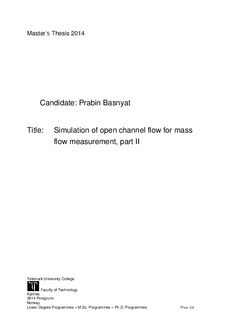Simulating open channel flow for drill mud mass flow measurement, part II
Master thesis
Published version
Permanent lenke
http://hdl.handle.net/11250/2439063Utgivelsesdato
2015-11-06Metadata
Vis full innførselSamlinger
Originalversjon
Basnyat, P. Tittel. Simulating open channel flow for drill mud mass flow measurement, part II, Telemark University College, 2014Sammendrag
Advancement in oil drilling technology, particularly managed pressure drilling requires better knowledge of return drill mud flow. Since the mud outflow is in an open channel, it is proposed to use flume with constriction that is based on Venturi principle for flow rate measurements. Rheological study of bentonite-base fluids as a non-Newtonian drilling fluid has been performed as well as CFD simulation of these fluids has been done for analysis of non-Newtonian fluid flow behavior. Rheology is termed as 'rheallycomplicatedology' by Steve Devereux[1]. It is tried to keep this study as simple as possible, and this report is focused on bentonite-base fluid only. Rheograms are based on Herschel-Bukley model. Rheogram of bentonite-base fluids without yield stress show Newtonian fluid characteristics i.e. shear stress vs. shear rate being linear and passing through the origin. Rheogram of bentonite-base fluids with yield stress as non-Newtonian fluid is similar to log plot. The geometry used for CFD simulation are the flume from the manufacturer BAMO and bachelor of science group 2013. ANSYS FLUENT is used to analyze the fluid flow behavior and liquid levels, using multiphase volume of the fluid model for bentonite-base fluid both as Newtonian and non-Newtonian. Bentonite-base fluids as Newtonian exhibit similar results as simulation conducted on water by master group project fall 2013 while, as non Newtonian, inlet surface profile gets steeper and steeper with the increase in concentration of bentonite. This is due to increase in viscosity of the fluid by the increase in concentration. It can be said that viscosity plays a vital role on defining the characteristics of the drilling fluid. Fluid flow along the flume at different time step shows a bit different properties for different concentration of bentonite base fluids due to change in viscosity, but the flow pattern is same. First, level of fluid reaches higher elevation due to fluid jump and finally, reaches steady state. This behavior should be considered during level measurement because it is expected to measure the level at steady state.
